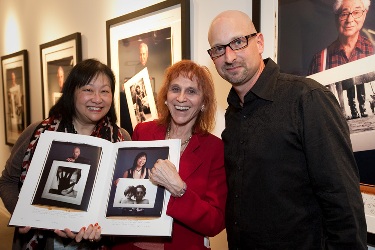Trust is key in making a relationship work. I know that, as a psychologist. Trust is crucial for lovers, and between photographer and subject.
Accordingly, “Trust” is a subtitle of a section of favorite photographs held by their image-maker, featured in the new book “Behind Photographs – Archiving Photographic Legends. The exquisitely published coffee table book produced by photographer Tim Mantoani includes a range from collector’s item portraits of icons like Mother Teresa, Bruce Springsteen and Nelson Mandela to jaw dropping images of war refugees, an Iraqi boy injured by an explosive, an AIDS-ridden child.and a row of Russian missing forearms deformed by pollutants. There’s also Cuba’s Fidel Castro smiling and hugging grinning Soviet Premier Nikita Khrushchev when they met at the United Nations General Assembly on September 20, 1960 – an encounter of particular interest to me, as an NGO representative at the UN who has sat in on GA sessions when heads of state make presentations each September.
Imagine. That’s another favorite psychological term. Imagining allows you to fulfill your dreams, consistent with the inspirational saying, “If you can see (imagine) it, and believe it, you can be it.”
Imagine is also the title of one of John Lennon’s most popular albums. Imagine if you were up close to that icon of our times.
May Pang was. The photographer and Feng Shui jewelry producer is an icon of sorts herself as the one-time assistant to Lennon and Yoko Ono who became his lover during the 1973-1975 interim phase of that relationship, referred to by Lennon as the “Lost Weekend.”
Pang’s contribution in Mantoani’s book was taken in the summer of 1975 on the Long Island Sound, capturing Lennon in a charming pose with his young son Julian.
“I helped bring the two of them together that summer,” Pang told me.

Pang answered a burning question, “Was John Lennon a good lover?” with an enthusiastic, “Yes.” When I asked her to elaborate, she replied that he knew how to please a woman first and even taught her a few things. These are all excellent signs, I told her.
Another stunning photo is the Fab Four in 1964 caught midair jumping onto a bed when told by their manager Brian Epstein that they were number 1 in American and going to New York.
Besides the Lennon shots, you can “Imagine” why I marveled at a youthful Elvis Presley caught on celluloid June 30th 1956 backstage at the Mosque Theatre in Richmond Virginia clearly tongue-kissing an unknown date. It reminded me of how Gene Simmons once thrust his (albeit longer) tongue down my throat backstage at a concert in the days when I was hosting my Z100 “LovePhones” call-in radio show.
Imagine doing something innocently at one point in time that decades later becomes outrageously valuable. Lori Grinker did that as a student in 1980 when doing a project on young boxers, taking a picture of then 14-year old Mike Tyson, being told he would become the next great heavyweight champion – and then he did! She followed the later-ear-biting champ for 10 years, and is quoted in the book saying, “He was a troubled but sweet kid who veered off the good path he was led to with all that comes with being a celebrity in that world.”
Similarly, Amy Arbus in 1983 stopped a then-unknown young woman on the street (whom she recognized as a girl in her gym who sat around naked in the locker room) to ask for a picture who said she still had her pajamas on, was grateful since she would be famous one day. The girl turned out to be Madonna.
At the book reception and exhibition recently in New York City, Mantoani described the psychological value of a still photo that you can look at again and again. “It tends to burn into your psyche. It becomes ingrained in your mind.”
Seeing the groundbreaking image-makers with their favorite subjects not only puts a face to their work, but reveals another interesting psychological principle in Mantoani’s description of how over time photographers develop their own way to seeing and their individual style. Indeed for all of us, “We all have our own personalities…our own voice and our own style.”
Convincing the photo takers to pose with their images was surprisingly not always easy. “Some were shy,” Mantoani told me. But he was persistent, driven to show young generations what these artists have done and to be inspired to create their art.
His words reminded me of a young Japanese girl in the class I taught at Tokyo’s Aoyama Gakuin University. After my lecture about following your dreams, she came up to me and told me of her dream to become a photographer, but her parents’ disapproval, wanting her to do something to insure a more secure future. She cried as I encouraged her to go for her dream.
Another valuable psychological message in the book comes from a photo of children jumping high in the air off a rock onto the sand at a beachfront on the Marshall Islands in 1997. The notation by photographer Mark Edward Harris says wisely that “kids don’t need money to entertain themselves…a lesson we should all keep in mind.”